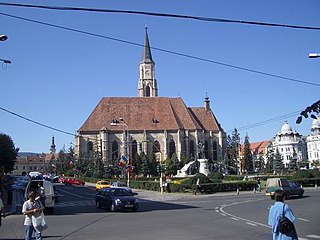
Cluj-Napoca, or simply Cluj, is the second-most populous city in Romania and the seat of Cluj County in the northwestern part of the country. Geographically, it is roughly equidistant from Bucharest, Budapest and Belgrade. Located in the Someșul Mic river valley, the city is considered the unofficial capital of the historical province of Transylvania. For some decades prior to the Austro-Hungarian Compromise of 1867, it was the official capital of the Grand Principality of Transylvania.

Aiud is a city located in Alba County, Transylvania, Romania. The city's population is 21,307 (2021). It has the status of municipiu. The city derives its name ultimately from Saint Giles (Aegidius), to whom the first church in the settlement was dedicated when built.

Avram Iancu Cluj International Airport is an airport serving the city of Cluj-Napoca, Romania. Initially known as Someșeni Airport, it is located 9 km (5.6 mi) east of the city centre, in the Someșeni area, which is now within the Cluj-Napoca city limits. The airport is named in honour of Romanian revolutionary Avram Iancu.

Dej is a municipality in Transylvania, Romania, 60 kilometres (37 mi) north of Cluj-Napoca, in Cluj County. It lies where the river Someșul Mic meets the river Someșul Mare. The city administers four villages: Ocna Dejului (Désakna), Peștera (Pestes), Pintic (Oláhpéntek), and Șomcutu Mic (Kissomkút).
Gheorghe Funar is a nationalist Romanian politician, who rose to fame as a controversial mayor of Cluj-Napoca between 1992 and 2004.

The St. Michael's Church is a Gothic-style Roman Catholic church in Cluj-Napoca. It is the second largest church in the geographical region of Transylvania, Romania. The nave is 50 meters long and 24 meters wide, the apse is 20×10 m. The tower with its height of 76 meter is the highest one in Transylvania.
Avram Iancu was a Romanian lawyer known for his participation in the Transylvanian Revolution of 1848–1849.

The Capitoline Wolf Statue in Cluj-Napoca, Romania is located on Eroilor Boulevard, in the city centre on the banks of the Someșul Mic River.

The Dormition of the Theotokos Cathedral is the most famous Romanian Orthodox church of Cluj-Napoca, Romania. Built in a Romanian Brâncovenesc style, a synthesis of Renaissance and Byzantine architecture, it lies on the Avram Iancu Square, together with the Cluj-Napoca National Theatre and the Avram Iancu Statue.

The Matthias Corvinus House is one of the oldest buildings in Cluj-Napoca, Transylvania, Romania. It was built in the 15th century, in the gothic style, as a small guesthouse. During its history, the house served as a jail, hospital, and museum; it is now home to a visual arts institute.
Iuliu Hațieganu University of Medicine and Pharmacy in Cluj-Napoca, Romania, is the oldest medical education institution in Transylvania, a continuation of the Faculty of Medicine which was founded in 1919, as a part of the Superior Dacia University. The university has over 6,000 national and international students, 2,400 resident physicians, as well as over 1,100 teachers and researchers. It was named in honor of the scientist Iuliu Hațieganu. The university is classified as an "advanced research and education university" by the Ministry of Education.

Piața Unirii is the largest and most important square in the Romanian city of Cluj-Napoca. The square is one of the largest in Romania, with dimensions of 220 m by 160 m. The central district of the city spreads out from this square. The St. Michael's Church, with the highest church tower in Romania (80m), is the second largest Gothic-style church in Romania. The church was constructed in two phases. The first from 1316 to 1390 and the second from 1410 to 1487. Also, the statue of King of Hungary Matthias Corvinus is located here.
Avram Iancu Square is a central plaza in the Romanian city of Cluj-Napoca. It is connected to the Unirii Square through the Eroilor and "21 Decembrie 1989" avenues. It is also connected to Mihai Viteazul Square through Cuza Vodă Street. Its most prominent building is the Dormition of the Theotokos Cathedral, although the plaza also houses the Wagner Gyula's eclectic Palace of Justice, the Lucian Blaga National Theatre and the headquarters of the County Prefecture.

The Ethnographic Museum of Transylvania is situated in Cluj-Napoca, Romania. With a history of almost 100 years, the Ethnographic Museum of Transylvania is one of the first and greatest of its kind in Romania. It has two exhibition sections, one of which is to be found in downtown Reduta Palace, while the other exhibition section is the open-air Romulus Vuia Park situated on the city's north-west side, in Hoia Forest.

Victor Deleu was a politician from Romania.

The following detailed sequence of events covers the timeline of Cluj-Napoca, a city in Transylvania, Romania.

Hajongard cemetery, on Avram Iancu Street, is one of the oldest cemeteries in Cluj-Napoca, Romania, founded in the sixteenth century. It is one of the most picturesque sights of the city. It covers an area of approximately 14 hectares.





















